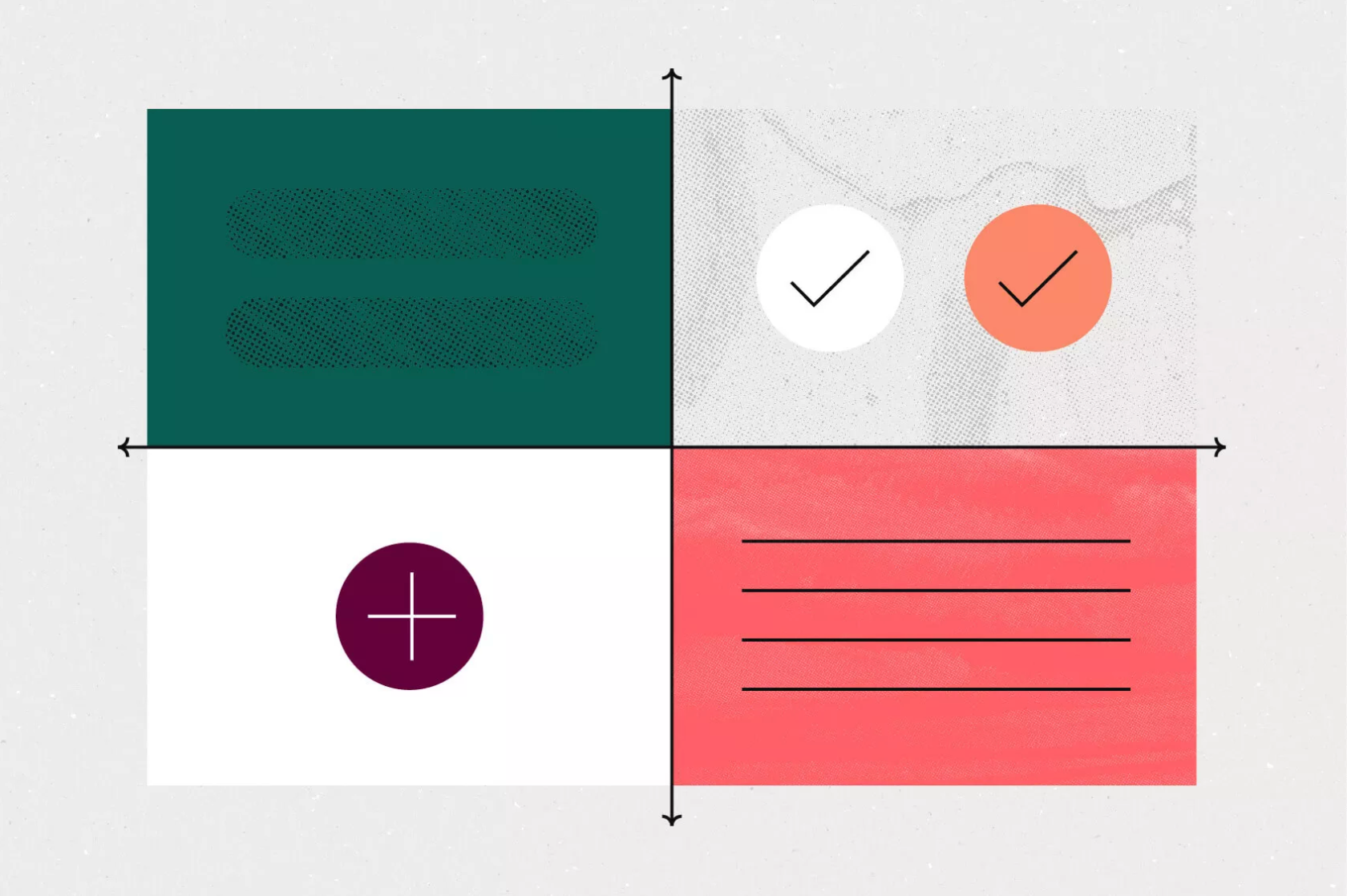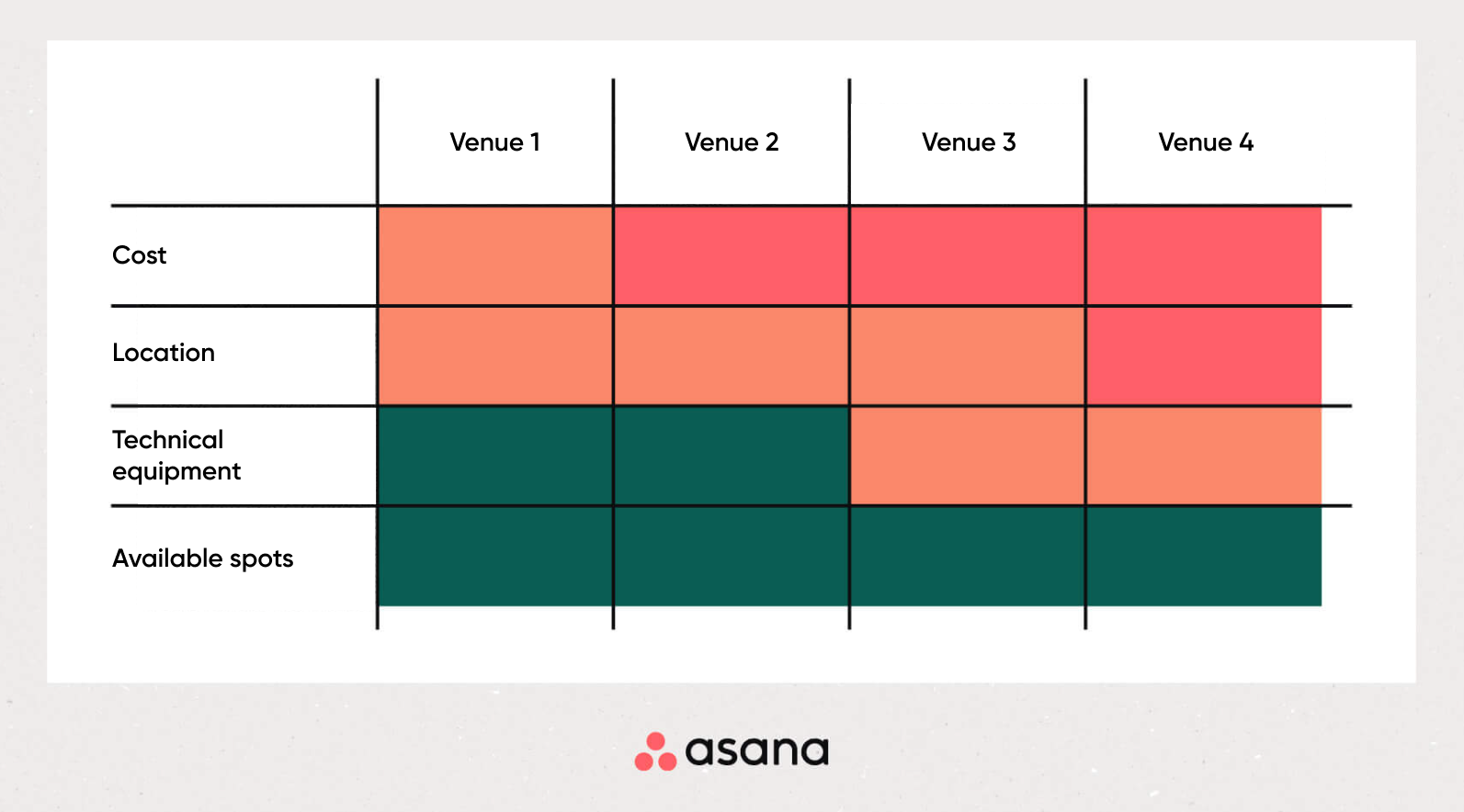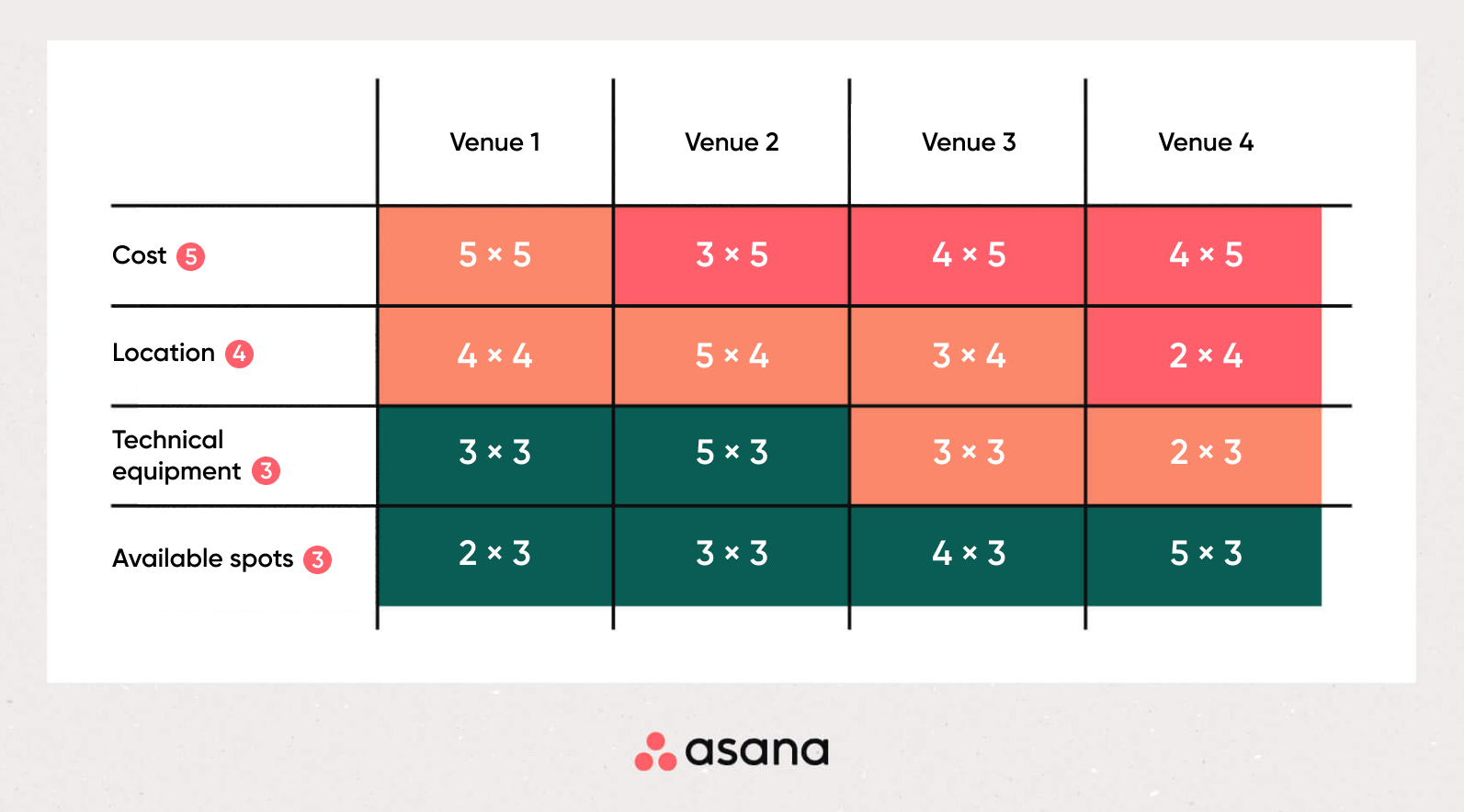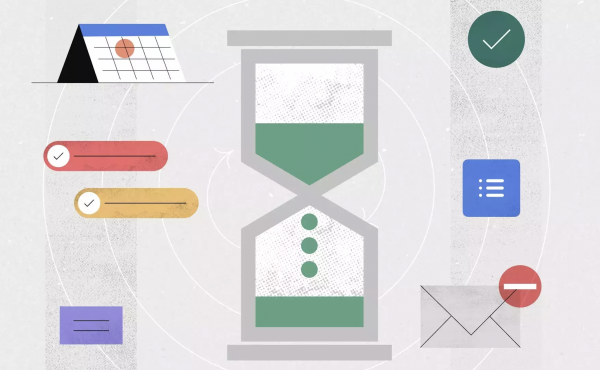Asana time tracking: What you should know
Decision matrix: 7 steps to make a decision

Our life, individual and professional, consists of choices and decisions we have to make every day. Such decisions can road you or your team in the right direction, helping to level up your performance and hit your goals.
Imagine you have some helpful analysis technique that helps you to make an important decision and to choose from different options. Would it be useful for you?
In this article, we would like to tell you about the decision matrix that will help you to analyze the pros and cons of different options and come out quickly with the best decision.
What is a decision matrix?
“What is a decision matrix?” is a phrase that many people have never heard before, but we will make an effort to explain its meaning.A decision matrix is a valuable tool to analyze and select the best option for different alternatives while making a decision. This technique is significantly helpful when you struggle to make a final decision between possible solutions with the impact of various factors.
A decision matrix can help you to:
- Reduce decision tension and fatigue
- Reduce a level of uncertainty and subjectivity
- Make all the options clear and prioritize them
- Make a confident and rational decision
When to use a decision matrix?
As we have already highlighted, the decision-making matrix is a helpful tool when you struggle to choose from some options. However, these different choices should be comparable. If you have a decision to make, such as – “In what direction should our company’s marketing strategy go for the next 2 years”, you won’t succeed using the decision grid.
You should primarily use decision making matrix analysis if you need to:
- Compare multiple but similar options
- Narrow some options into the final decision
- Evaluate a variety of essential factors
- Aim to find the logical point of view out of rational analysis
So, the decision matrix is the right choice for you if you are struggling with complex criteria and multiple comparable options.
How to make a decision matrix?
Let’s say you need to choose a venue for the upcoming event you hold in your work to get some prospects or give essential updates to your existing customers in the area. Here are the seven steps to creating a decision matrix:
1. Identify your alternatives
Before building your matrix, you should find different options you can decide between. In this case, you can discover, for example, four locations in the city that are suitable for your event.
2. Identify criteria for analysis
Having identified the options, you should establish the crucial criteria you need to evaluate to make the best decision. In our case, some examples of the critical factors for the event venue can be the cost, the potential return on investment, location, distance from the office, number of available spots, availability of technical equipment, the possibility of organizing catering or lunch, past customer reviews, and others. You should always take into account that all of the options will have some pros and cons.
You are free to involve some of your partners and stakeholders to narrow down these criteria. It would help you concentrate on the most essential factors you must evaluate.
3. Create your decision matrix
A decision matrix example is a grid where you put important factors to analyze and compare them. After identifying the number of options and the crucial criteria, it is the right time to create a decision grid.
You can use the Asana work management tool to create a grid putting all your options and factors. You can set your choices as the column titles and your criteria as the titles of the rows.

4. Fill your decision matrix
Now you can start to evaluate your options according to the value criteria. You can use a scale from 1-5, where 1 is the worst and 5 is the best.
This is when you start to appreciate the decision matrix tool the most because you see the full image of your choices and the variety of important considerations in one place. You do not need to dive into the lengthy discussion about, for example, cost-effectiveness or other factors. Filling this decision grid helps you to work on each variable step by step without the risk of missing something.

5. Add weight to your factors
When you analyze and scale all of your choices, it is time to put weight on your criteria. Some can be more crucial than others, so it is important to visualize them in your solution matrix to get the highest ranking.
For example, the cost for you is essential, considering that you can not exceed your budget. At the same time, the location is a little less important but counts more than technical equipment and the number of available spots. So the last ones matter equally, but a little less than others.

6. Multiply the weighted score
In this step, the most challenging work is already done. Now you just need to multiply the weight by each factor. To continue our example, here’s what it looks like when you apply the weighted scores to each aspect of each venue:

7. Calculate the total score
Finally, you have counted everything you needed to find the best solution for your event. Now, you have a clear, number-based answer according to your essential criteria and their significance level. All you have to do is calculate the total score for each option, and you’ll make the most accurate and rational decision (in our case, it would be venue number 2 ).

Decision-making alternatives
Eisenhower matrix
The Eisenhower technique is a 2×2 grid that helps you to prioritize your tasks by urgency and importance. Here you can evaluate the variety of non-similar tasks and decide what is the best to work on first.
To make this evaluation happen, you should divide your grid into four squares:
- In the upper left-hand corner, list urgent and essential work. It would be your most prioritized task to complete as soon as possible.
- In the upper right-hand corner, list less urgent but important work. Because this work is not so urgent but important, it is better to add it to your calendar or use some project management tool to avoid forgetting about it.
- In the lower left-hand corner, list urgent and not important work. These tasks need to get done quickly, but you can delegate them to your colleagues.
- In the lower right-hand corner, list less urgent and not important work. To reduce possible burn-out, these are the tasks to eliminate from your workflow, and let your team know about it.
Stakeholder analysis map and RACI chart
It is also crucial to decide which stakeholders should be included, consulted, or informed during your decision-making. A stakeholder analysis map can help you to categorize your stakeholders based on their influence and interest in the project.
For this, you can use four categories:
- High influence and interest: these stakeholders should be involved in project planning and decision-making.
- High influence and low interest: these ones should be able to monitor the project in case they want to become more involved.
- Low influence and high interest: these stakeholders should also be informed about all the project status updates.
- Low influence and low interest: these colleagues should be included in the project checkpoints but should not necessarily be informed about project updates.
After performing this analysis, you can create a RACI chart (Responsible, Accountable, Consulted, and Informed). This chart will help you discover the best decision-maker for each task and each step of your project.
Team brainstorming
Sometimes the best way to decide is to host a fabulous old-fashioned team brainstorm. Hold a whiteboard brainstorming session or share ideas in a project management tool.
To do this, Asana proposes to you to use Kanban boards where the team members can share their thoughts, cooperate with the individual suggestions right in Asana by “likes,” and discuss everything after filling up the board.
You can learn more about the decision-making matrix and the other solutions and tools possible with Asana from our experts. With the Asana work management tool, you can make your workflow more goal-oriented without spending lots of time on endless discussions or routine manual tasks and get the most out of your work time.

Cloudfresh is an Asana Solution Partner and a unique center of expertise for Asana, Google Cloud and Zendesk. For these products, we can provide you with the following services:
- Customization;
- Development;
- Integration;
- Training;
- License;
- Support.
Our specialists will help you optimize your IT infrastructure, develop integrations for better system interoperability, and help create entirely new structures and processes for your teams, while our support center will provide you with the best customer experience!












